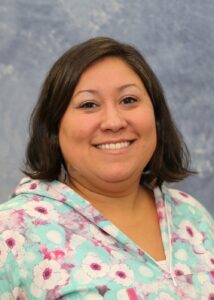Dr. Pearl K. Brower is the former president of Iḷisaġvik College, the northernmost community college in the United States. Iḷisaġvik College is Alaska’s only tribal college, and is the only independently funded public community college in the state. Iḷisaġvik primarily serves a region of Alaska’s North Slope Borough that is about the same size as the state of Oklahoma, where all eight communities are accessible only by plane.
With a focus on community, Iḷisaġvik primarily recruits students from the North Slope communities that it serves, although their unique, culturally responsive institution attracts students from every region of Alaska. They also have a few students from the lower 48 states who attend virtually every year.

Dr. Pearl K. Brower
In October 2020, after eight years serving as president of Iḷisaġvik College, Dr. Brower stepped down. She was succeeded by Justina Wilhelm, former vice president of Iḷisaġvik College. Dr. Brower stayed on in an advising capacity through the end of 2020 to facilitate the transition and impart lessons gained from her years of experience leading the college.
Dr. Brower recently spoke with Achieving the Dream about Iḷisaġvik College’s work with the organization, the transition, the strategies that helped her lead during a time of global upheaval, and the unique challenges and benefits of running one of the most remote institutions in the country. This conversation has been edited for length and clarity.
Achieving The Dream: One of the things we focus on at Achieving the Dream is student success, and that looks different at every college. Is there anything you think is unique to Iḷisaġvik College when it comes to promoting student success?
Dr. Pearl Brower: The biggest thing, and this is true for all tribal colleges, is our focus on being culturally centered and culturally minded, and how valuable that is when a majority of your students are of an Indigenous heritage. When you have an institution that is a reflection of who you are as a person, I believe that allows for you to be more successful as an individual. It allows for students to feel like they belong.
We also have small class sizes. We have very individualized services. Because we are very community-centered and community-minded, we’re able to provide good access and support for our students’ success.

Photo courtesy of Iḷisaġvik College
ATD: You and the school are in a time of transition right now, which already comes with challenges but is now happening during a pandemic. How do you think leaders can continue to prioritize student success during times of transition?
PB: The biggest thing is to always remember that students are at your core. Another part of it is to be really communicative. Trying to stay open and responsive was key during this time. Most people aren’t going to take [a given message] in on the first go, so say things often and repeat yourself. It was actually our ATD coach, Dr. Connie Green, who taught me that.
ATD: Initially you were hesitant to join the ATD Network [Note: Iḷisaġvik College became an ATD Network institution in 2017], but now you’re an advocate of ATD and the work we do. Can you talk about what made you go from “No” to “Yes”?
PB: At tribal colleges, you don’t have five people on the bench waiting to go in and substitute for your star player. We have one person running a whole office, and maybe sometimes running two or three. We had just hired Justina Wilhelm [as executive director of institutional advancement], so I I asked her, “Would you be game to take the lead and run with this?” She said she absolutely would.
Within three to six months, all of our team was glad that we took [the opportunity to join ATD] because we found so much value in our coaches. Connie and Leon were amazing. They got who we were, and what they gave to us was so valuable and meaningful that we started to see changes pretty quickly. That definitely helped with getting buy-in from others. The first [reaction] was, “Oh my gosh, how in the world are we going to do this?” And then the follow-up was, “I’m so glad we did.”
ATD: Are there any examples during your time working with ATD that stand out to you where the work really facilitated change or made a difference with student success?
PB: For me, the biggest thing that I took away as a leader was Connie’s help with communication. On the student success side, we started our first-year pathways program—all incoming freshmen are in a cohort model and they’re going through a pathway together. This spring we start the fourth iteration of this program. I think that is huge for our institution, trying to make sure that our incoming freshmen get the support that they need. The first-year pathway is designed to do that, and that’s a direct result of [our work with] ATD.

Photo courtesy of Iḷisaġvik College
ATD: Obviously, there were major differences in your role as you transitioned out of a position of leadership and helped President Wilhelm onboard. Is there anything that surprised you about what changed in your role with the college, or what didn’t?
PB: One of the things that surprised me was how much positive feedback President Wilhelm and I received from our employees about our transition. Employees shared that they felt much more at ease knowing that 1) President Wilhelm and I had been working together in a positive, productive working relationship for the past three years, and that 2) while I took a back seat, President Wilhelm and I still had open communication and continued to work together ensuring a smooth transition. What a great way for her to enter into leadership of the college by acknowledging the outgoing president, recognizing the great work the institution accomplished in the past eight years, and sharing her vision of where she will take the institution building upon the framework of the past.
I would also say that it’s emotional—this is an institution I’ve been at for thirteen years. It’s who I was. There were a couple bumps and bruises in the first week of transition, and then after that it worked like clockwork. We just got in a rhythm. President Wilhelm’s success was paramount, that was number one. And, and I think she recognized that I wanted her to be successful. I looked forward to being more of a mentor, adviser and coach while she took the reins. I really looked forward to not having to be the decision maker anymore. I felt great taking that step back as she took that step forward.
ATD: Given that the transition went so well, and there was support throughout the staff, is there any advice you would share with other college presidents beginning to undergo a leadership transition?
PB: Having a transition period is so critical to a successful leadership change. When there’s respect on the table and the luxury of time, having a tiered or gradual transition process allows for incredible transfer of knowledge. How could you, in a transition report, write down eight years of what you’ve done? That’s just not possible.
The other piece of advice is: Communication, communication, communication. The more communication you can provide, and the more information you can give, the better your employees feel about the transition. For example, in my weekly president’s emails in the last month before the transition, I included a section for then–Vice President Wilhelm to add her thoughts and information she felt was important for our employees to know. And then we switched: Once she assumed the role, I included a little weekly blurb as exiting president for about a month about what was going on within my purview.
And finally, make sure that your president has someone that they can talk to. It’s so helpful that President Wilhelm has Dr. Green as her continued leadership coach, and me as the past president. She has a direct line to the former president of Iḷisaġvik, plus an opportunity to dialogue with Connie, who has been president of other institutions. That’s a key piece in a transition—your president needs somebody who they can talk to.

Photo courtesy of Iḷisaġvik College
Iḷisaġvik College serves the residents of the North Slope Borough, America’s largest and most northern municipality, and provides an education based on the Iñupiaq cultural heritage. It is one of 33 Tribal Colleges and Universities (TCUs) active in the ATD Network. Learn more about Iḷisaġvik College here and ATD’s role in supporting student success at TCUs here.